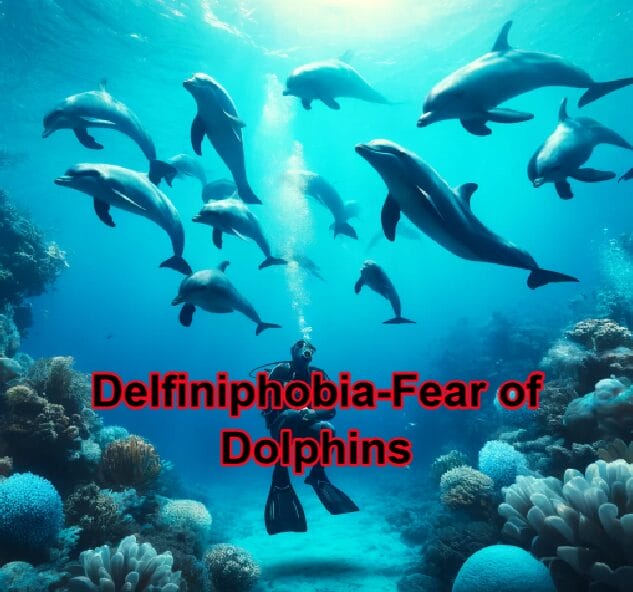Share This Article
Delfiniphobia: Navigating the Fear of Dolphins
Delfiniphobia, or the fear of dolphins, might sound surprising to many. After all, dolphins are often viewed as friendly and intelligent creatures featured in many feel-good movies and beloved aquatic shows. However, for those experiencing delfiniphobia, encounters with dolphins, whether in the ocean or at aquariums, can provoke intense fear and anxiety. Let’s explore this unique phobia, its origins, symptoms, and available treatments.
The Definition of Delfiniphobia
- Definition: Delfiniphobia is an intense, irrational fear of dolphins.
- Impact: This phobia can limit individuals’ activities, such as swimming in the ocean, visiting aquariums, or participating in water sports, significantly affecting their enjoyment of recreational activities.

How a Person May Develop Delfiniphobia
- Traumatic experiences: The fear can stem from a negative encounter with dolphins, such as a frightening experience while swimming or a scary scene involving dolphins in movies or media.
- Learned fear: Some individuals may develop delfiniphobia by observing others’ fearful reactions to dolphins or hearing alarming stories about dolphin encounters.
- Misinformation: Misconceptions about dolphins being dangerous can also contribute to developing this phobia.
Swimming with the Dolphins
Jessica had always enjoyed the sea as with many young girls she dreamed of becoming a marine biologist, studying the oceans known and unknown marvels. And as with most young people dreams change and reality sets a different path. Jessica eventually went into business management becoming very successful. Her success allotted her money and the time off to enjoy it.
She often frequented the Hawaii, enjoying the beauty of the blue clear water and the excitement of seeing the wildlife. Jessica had been close to dolphins twice in her life and found it to be almost a religious experience. The size of the intelligent mammal and noises and agility. This was how she felt until the day a pod of dolphins came up to her and her diving partners. One of the make dolphins was acting differently than any previous she had seen. This male was aggravated or looking to mate and was aggressive. The male dolphin bumped into Jessica quite hard twice and nipped at her legs, being six and half feet long and weighing over two hundred pounds the power was frightening. Nothing further happened on that trip but the fear had set in a started to manifest.
This fear turned excessive then into a full phobia. Images, sounds or even thoughts of dolphins would cause Jessica physical and psychological issues. Thinking of being in the ocean unprotected was overwhelming. Sweating and anxiety where the main two symptoms but sometimes full-blown panic attacks would occur.
Jessica is a smart and accomplished woman and knew therapy would be the best option. She started with a basic talk therapy regiment moving on to exposure therapy, looking at and hearing dolphins started the path to realizing dolphins are not a danger, especially if you stay on dry land, getting back into the ocean will take some time but Jessica is taking the right steps towards swimming with the dolphins again in the future.
Symptoms of Delfiniphobia
Physical Symptoms
- Panic attacks: Symptoms such as rapid heartbeat, sweating, shaking, or difficulty breathing when thinking about or seeing dolphins.
- Avoidance: Actively avoiding places where encountering dolphins is possible, such as oceans, beaches, or marine parks.
- Nausea: Experiencing queasiness at the thought of dolphins or when seeing images of dolphins.
Mental/Emotional Symptoms
- Intense anxiety: Overwhelming dread or panic at the thought of dolphins or dolphin-related content.
- Sleep disturbances: Nightmares about dolphins or disrupted sleep due to anxiety.
- Emotional distress: Feelings of helplessness or embarrassment over the phobia’s impact on their life.
Treatment: Self-Help and Professional Help
Self-Help Strategies
- Education: Learning about dolphins and understanding that they are generally non-aggressive can help reduce fear.
- Relaxation techniques: Techniques such as deep breathing, meditation, or progressive muscle relaxation can help manage anxiety.
- Visualization: Picturing calm interactions with dolphins or visualizing oneself enjoying watching dolphins from a safe distance.
Professional Help
- Cognitive behavioral therapy (CBT): Helps modify negative thoughts about dolphins and teaches coping mechanisms to manage anxiety.
- Exposure therapy: Gradually and safely exposing the person to dolphins, starting with pictures, then videos, and potentially visiting aquariums under controlled conditions.
- Support groups: Connecting with others who have similar fears can provide support and coping strategies.
In Conclusion
Delfiniphobia is a testament to the vast range of human experiences and how diverse our reactions can be to the same stimuli. For those struggling with this fear, understanding the phobia’s roots and actively seeking treatment can be transformative. The journey to overcoming delfiniphobia might be daunting, but with the right strategies and support, it is possible to move past the fear and rediscover enjoyment in activities once avoided. Whether through self-help efforts or professional guidance, each small step towards managing this fear is a leap towards a freer, fuller life.



